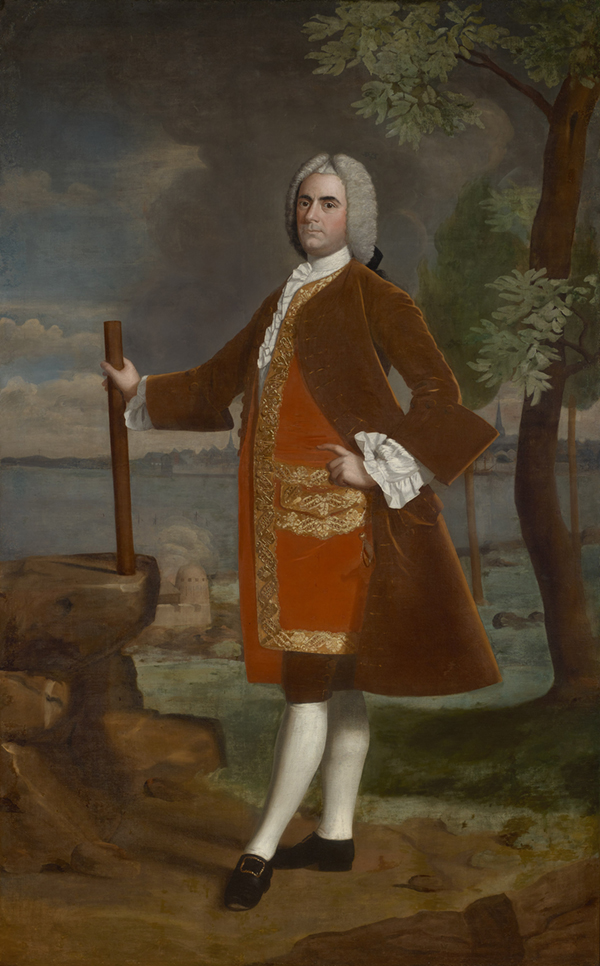Robert Feke's "Portrait of Brigadier-General Samuel Waldo"
By Bowdoin College Museum of Art
Portrait of Brigadier-General Samuel Waldo, ca. 1748, oil on canvas by Robert Feke, American ca. 1707–1752. Bequest of Mrs. Lucy Flucker Thatcher. Bowdoin College Museum of Art.
December's "Object of the Month" reconsiders one of the Museum's colonial masterpieces: the full-length portrait of Samuel Waldo (1695–1759) by the early American portraitist Robert Feke (ca. 1707–1751). Joining the Museum’s art collection in 1855, the gift of Waldo's great-granddaughter, the painting is known to generations of visitors. Its artist Robert Feke merged his ambition with natural talent, earning major commissions for portraits of the residents of Newport, Rhode Island, and Boston, Massachusetts. Considered Feke's masterwork—for its painterly quality, historical significance, monumental size, and remarkable provenance—it holds a notable place in the history of art in colonial America. As demonstrated by the Museum's object file, brimming with exhibition notices and publication requests, the picture has been studied and published for decades. But today, we ask new questions of this portrait to examine the sitter’s role in colonization and enslavement in colonial British America.
Waldo has long been recognized for his role in the 1745 British and American victory over the French at the city and fortress of Louisbourg, Nova Scotia, depicted in the background of his portrait. A celebratory painting, it was one of five contemporaneous portraits – four full-length and one three-quarter length – of the commanders of that battle. In 1745 and 1746 John Smibert painted those of American commander and Kittery merchant William Pepperrell, Massachusetts governor William Shirley, and from the British Navy Commodore Peter Warren and Captain Richard Spry. The surviving Pepperrell portrait can be found at the Peabody-Essex Museum, Spry and Warren at the Portsmouth Atheneum. (Shirley's portrait does not survive.) Feke excelled in the painterly details of Waldo’s luminous silk-velvet coat and red waistcoat trimmed in yards of thick gold braid. Based on his 1759 probate inventory, Waldo was quite the clotheshorse. In a large horsehair wig, Waldo strikes a pose guided by British etiquette books. He holds a baton, symbolizing his status as a brigadier-general, but instead of being depicted in a uniform, he is dressed as the prosperous merchant he was. From his home in Massachusetts, he secured rights to the Waldo Patent, comprising land between the Penobscot River and Muscongus Bay, now part of Maine, and worked toward its settlement and development.
What has not been acknowledged about Waldo is that his wealth, like that of many other Bostonians of his time, was derived as a slave trader in west Africa and as an enslaver in Boston as early as 1728. Beginning in 1930 scholars Lorenzo J. Greene, Elizabeth Donnan, and others separately documented Waldo's enslaving activities. With few exceptions, however, these remained unacknowledged in discussions about the portrait. In the 1730s Waldo advertised his sale of individual African men, women, and children in the newspapers. In the Boston Evening Post (October 23, 1738), he listed enslaved Africans as just one commodity among others—"Good Florence Wine in Chests, good Irish butter by the Firkin, at Two Shillings per pound, and a likely [or strong and capable] young Negro Fellow." His slave-trading is revealed by Suffolk County Court records which document the circumstances of a 1734–1736 voyage of his sloop Africa, used to transport enslaved Africans from the coast of Guinea to the Caribbean island of St. Eustatius. When the majority of the 200 enslaved Africans on board perished of the "flux" or dysentery, Waldo sued his captain in an effort to recover his substantial losses. Following appeals, Waldo lost his case and settled with his captain.
Research continues into Waldo's involvement as a Boston merchant in the African slave trade, as well as his efforts in the mast trade and other business enterprises in Maine, particularly Falmouth-in-Casco-Bay (colonial Portland). A re-examination allows us to consider not only the source of his wealth and the larger history of enslavement in what is now the United States but also how that financial success further enabled his personal and military achievements. Feke's portrait will be included in Enlightenment and Empire: European and American Art, 1475–1875, a reinstallation of the permanent collection in the Bowdoin Gallery, on view beginning in February 2021.
Laura F. Sprague, Senior Consulting Curator
Elizabeth Humphrey, Curatorial Assistant and Manager of Student Programs
Bowdoin College Museum of Art